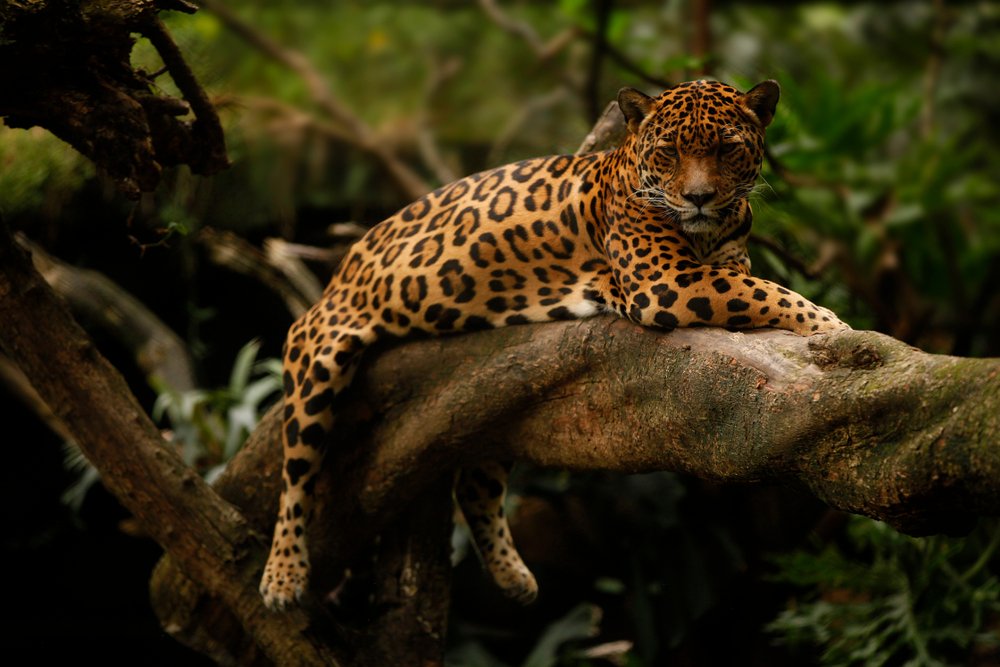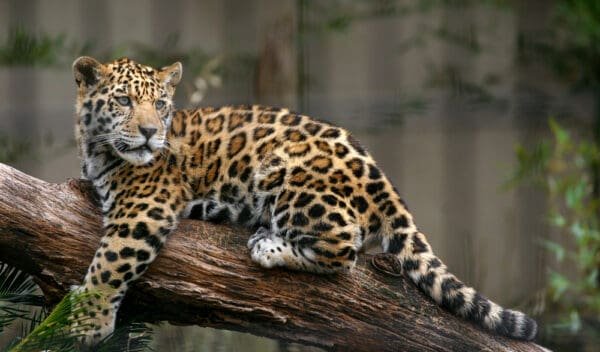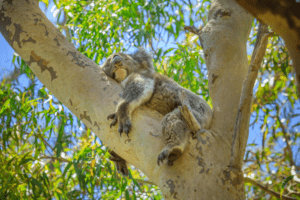Have you ever wondered that What Do Jaguars Eat In The Rainforest?, “What is the main prey of jaguars?”, “What do jaguars consume?” and “how do they hunt?” in a more systematic approach.
When you imagine a fearsome beast, you might wonder why it’s named after jaguars, and you might wonder what the origin of the word “Jaguar” is. The origin of the word “jaguar” is the Tupi and Guarani languages of South America. The phrase yaguareté, which means “he who kills with one leap,” is a plausible origin. So it’s no surprise that why this animal’s name is Jaguar.
Table of Contents
What Do Jaguars Eat In The Rainforest? Taxonomy and appearance
Among all surviving members of the Panthera genus, the jaguar scientifically known as Panthera onca is the sole living species on the American continent. It’s the 3rd largest Felidae in the globe and the biggest with respect to size in the Americas. It is a member of the Carnivora order. They are also the most dominant predators in their biological niche.
It has a strikingly patterned coat with soft yellow to light brown skin, and black dots are prominent on its thick fur that transition to rosettes on the sides. Jaguars can be “melanistic,” which means they appear to be black jaguars. However, melanistic leopards and jaguars are regarded as “black panthers,”
Jaguars and leopards look identical to the untrained eye, however, their rosettes (circular markings) distinguish them: Leopards do not have black spots in the midst of their rosettes, although jaguars have. Jaguars are also distinguished by their huge, rounded heads and short legs.

Habitat and main diet
Jaguars can be found in desert scrubland, tropical rainforests, coastal mangroves, grasslands, swamps, along river basins, and mixed-conifer forests, among other places. They tend to congregate near water bodies. Capybaras (Hydrochaeris hydrochaeris) are the main prey of jaguars.
Rain forests are the most diverse terrestrial ecosystem in the world, providing a wide range of food, and the jaguar is the most dominant predator in its ecological niche. As a result, it’s not surprising that the question “what do jaguars eat in the rainforest?” springs to mind.
Ecological Niche
Jaguars are indeed at the top of the pyramid in trophic levels and dwell in the forest. The diversity of animals shares this ecosystem, allowing them to consume over 85 different types of prey. Rather than chasing their prey, they stalk and ambush it. Jaguars can travel considerable distances to prey if food is short.
Jaguars are excellent swimmers, proving that not all cats despise water. As a result caiman, fish, and turtles become easy prey. The Jaguars spend a lot of time on the land surface. They walk silently across the forest floor on their soft paws however; they aren’t quite as nimble as leopards. Jaguars are skilled tree climbers, although they are not arboreal, but they use this ability to hunt or relax. The Jaguars have a unique role or specialization in creating the ecological balance.
Feeding Habits
When come to diet patterns it is vital to retain information that jaguars are opportunistic, highly proficient at hunting, and incredibly apex predators in their ecological niche. Jaguars have adapted to ingest over 85 different types of animal species that dwell with them in their biologically diverse rainforest ecosystem.
Jaguars are skillful hunters and very opportunistic in their predation and they can eat nearly everything. Jaguars consume iguanas, capybaras, deer, fish, armadillos, tortoises, monkeys, birds, and many more. They are also capable of hunting the tapir, which is South America’s largest animal, as well as large carnivores like the caiman.

List of the most preferred animals jaguars commonly eat in the rainforests:
- Capybaras (Hydrochoerus hydrochaeris)
- Monkeys
- Black agouti (Dasyprocta fuliginosa)
- Snakes
- Tamandua (Tamandua tetradactyla)
- Caiman
- Javelinas (also known as peccaries)
- Fish
- Iguanas
- Giant anteater (Myrmecophaga tridactyla)
- Rabbits
- Turtles
- Armadillos
- Collared peccary (Dicotyles tajacu)
- Tapir
- Marsh deer (Blastocerus dichotomus)
- Birds
- Bird and reptile eggs
- Livestock animals
Jaguars, on the whole, aren’t crayon eaters. They can easily take down any animal that is easy for them to ambush and incapacitate. Furthermore, as apex predators, they have no natural predators. As a result, their jungle homes are virtually personal banquets for them!
So, how do jaguars kill such a diverse range of creatures with such finesse and efficiency? Let’s talk about how their bodies are made for hunting and tearing their prey apart.
Hunting skills
- Jaguars are both nocturnal and diurnal big cats, as they hunt both during the day and at night, and can travel up to 10 kilometers (nearly 6 miles) per night.
- Jaguars have the strongest bite of any Felidae. Their teeth are powerful enough to penetrate crocodilians’ thick skin and crumble turtles’ sturdy shells.
- They require strong teeth and jaws to consume food three to four times their own weight, and they normally kill it by biting the back of the head rather than the throat, as other Felidae do.
- Their tongues, like other Felidae, have sharp-pointed structures called papillae that are helpful to grab flesh from bones.
- jaguars have the ability to climb trees, allowing them to pursue and feed on arboreal species as well.

How do they hunt?
Jaguars are stealth hunters, which means they approach their prey very close and attack as soon as the situation is right. Their patchy fur coat allows them to blend in with their surroundings. They hide in plain sight until they are close enough to pounce and attack their prey. They can also suffocate an animal by biting through the skin. Another method of killing its victim is to bite the skull between the ears, piercing the brain with their canine teeth. Jaguars have extremely strong jaws, allowing them to accomplish this.
How much Jaguars eat
The daily consumption of jaguars is heavily influenced by the availability of prey and the calories contained inside it. Emmons (1987) estimated the dietary requirement of a jaguar having a weight of 34 kilograms needs to consume an average of 1.4 kilograms of meat per day.
Interesting facts about jaguars
- Jaguars, unlike many domestic cats, do not shun water. They’ve adapted to life in the water and can be found swimming in lakes, rivers, and wetlands. They are strong swimmers who have been seen to cross huge rivers.
- Both males and females roar when they desire to mate, which helps to bring them closer.
- The normal call of a jaguar is dubbed a ‘saw’ because it sounds like wood being sawed, but only in one direction.
- Jaguars make a nasally snuffling sound when greeting or reassuring one another.
- A pair of jaguars can mate up to 100 times each day when breeding. That’s considerably exhausting.
- The female normally gives birth to two jaguar pups after a 14-week pregnancy although she has the capability to have up to four pups.
- Jaguar cubs are born weighing roughly the same as a loaf of bread, but they quickly grow. Males can be 50 percent heavier than their female siblings at the age of two.
Conservation status
Jaguars are classified as Near Threatened by the IUCN red list. Jaguars can be found in their above-mentioned habitat all over the world, from the southwest of the United States to virtually the extreme north of Argentina. They are now practically extinct in half of their historic range.
Today, there are around 173,000 jaguars left in the world, with the majority of these big cats living in the Amazon rainforest and the Pantanal, which is the biggest tropical wetland on the planet. Brazil is their stronghold; it may host half of the overall wild population.
Threats to Jaguars

The jaguar confronts no natural risks from rival cats or other competitors, However, humans are the biggest threat to their population. Between the decades of the 1960s to 1970s, about 15,000 jaguars were slain to obtain their gorgeous fur.
While consumer education programs have managed to reduce the demand for jaguar fur, hunters continue to put the animals under stress. In addition, habitat degradation is increasing the number of human-jaguar confrontations. Jaguars are expected to survive in the future, according to scientists, thanks to a mix of defined protected areas and increased community knowledge.
Although demand for their skins has declined, since the mid-1970s, jaguar tusks, paws, and other parts are still in demand, primarily from China, for ethnozoology.
South America has a high rate of deforestation due to logging and to make room for livestock grazing. This offers various new threats to jaguars, ranging from loss of natural habitat to population separation, making breeding more difficult. Prey for jaguars is depleting as their habitat shrinks; roughly one-fifth of their region is thought to be devoid of wild creatures.
As a result, they prey on livestock and are hunted down by people. Pouching is another serious threat to jaguars posed by humans though it is against the global legislation.
Body structure supporting predation skills
Jaguars can grow to be up to six feet long from the head to the tip of their tail, and their shoulder height may reach up to three feet. The normal male jaguar weighs around 54.43 Kilograms, but some can weigh up to 136.08 Kilograms, and female jaguars can weigh as little as 100 kilograms. Most jaguars are born weighing less than one kilogram.
Read Also: What Animals Eat Monkeys?
References
https://www.iucnredlist.org/species/pdf/123791436
https://link.springer.com/article/10.1007/BF00292180
http://www.scielo.org.mx/scielo.php?pid=S2007-33642021000100075&script=sci_arttext&tlng=en
https://www.cbd.int/undb/media/factsheets/undb-factsheet-pa-en.pdf
http://iucnosg.org/Bulletin/Volume24/Volume24_pages.pdf





